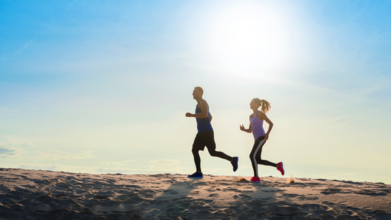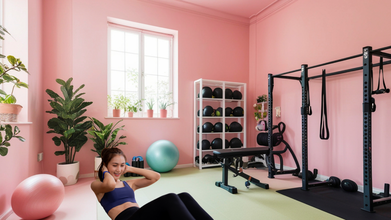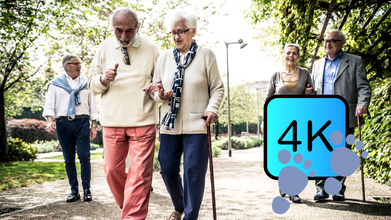- Health Conditions A-Z
- Health & Wellness
- Nutrition
- Fitness
- Health News
- Ayurveda
- Videos
- Medicine A-Z
- Parenting
- Web Stories
Does Your Metabolism Really Slow Down With Age? Here Is The Truth

We have all heard the elders saying it is harder to lose weight after 40 because your metabolism slows down. But is that really the case, or are we blaming something that is not even responsible? Fitness expert Jaymie Moran took to Instagram to break down what actually happens as we age, and his take might surprise you.
Your Metabolism Does Not Suddenly Tank at 40
Referencing a major 2021 study led by Duke University researchers that tracked 6,400 people ranging from infants to 95-year-olds, Moran mentions the study’s striking discovery: metabolism stays remarkably stable between the ages of 20 and 60.
“There is no magical slowdown and no flip that gets switched as soon as you turn 40,” Moran states. So if that is the case, why does managing weight suddenly feel so much harder?
It is Not Your Metabolism; It is Your Life
“Well, you are probably not going to like the answer,” Moran warns, “but we are here to cut the BS.” According to him, it is not about your metabolism at all; “It is your life.”
Moran explains how our lifestyle in our 40s looks vastly different from our younger years. “You are sleeping one or two hours less than you did in your 20s. You are sitting at a desk for eight or nine hours a day. Your active hobbies have turned into running the kids round or scrolling on Instagram in bed.”
And the main issue? Stress. “You are stressed out, never feel like you have any time, and are grabbing convenient crap that you probably would not have touched a decade ago.”
Hormonal Issues Add to the Chaos
“And let us not forget about perimenopause knocking on the door,” Moran adds, “which does change how your body stores fat, especially around your midsection.”
He points out that night sweats wreak havoc on your sleep, which in turn “absolutely screw with your hunger and fullness hormones”. As your hormones shift, you end up “moving less because you are exhausted, and you are probably eating more.” According to Moran, that is why the scale creeps up, not because your metabolism has suddenly failed you.
Same Old Strategy, Different Body and Life
Moran says the real problem is trying to apply the same health and fitness approach from your 20s, even though everything about your life and body has changed. “You are still trying to follow the same approach that you used in your 20s, even though your body and your life are very different now.” However, he says that weight loss and getting your health in check is still completely possible.
Smarter Strategy for a Smarter Body
According to Moran, you just have to adjust your strategy. His recommendations are clear:
- “Prioritise protein and fibre to maintain your muscle and control hunger.”
- “Get seven to eight hours of quality sleep. Your hormones will thank you.”
- “If you struggle with night sweats or you get too hot, buy a cooling mattress. It will literally change your life.”
- “Strength train two to three times a week for 30 to 60 minutes. This is a non-negotiable if you want to age strong.”
- “Walk more. You have got to be doing at least 8,000 steps a day.”
If 8,000 sounds like a stretch, Moran has a simple plan: “If you are at 4,000 or 5,000, start adding 1,000 a month on until you get to 8,000 and just make it part of your daily routine.”
It is About More Than the Scale
Moran ends with a powerful reminder: “This is not just about the number on the scale. This is about your energy, your strength, your confidence, your independence, your self-esteem, and staying capable.”
Did President Trump Have A Stroke? His Walk Suggests So, Says A 'Physical Therapist' As He Explains How Someone's Gait Can Reveal A Lot

Credits: AFP and Instagram
"He walks like this because he's had a stroke and his spatial awareness, balance, strength and gait have all been affected," says a person who claims to be a 'Physical Therapist at a home healthcare, and claims to have a doctorate in his field with 14 years of experience. The video is posted on his Instagram channel @epistemiccrisis with 74.2k followers.
What Are His Claim About President Trump's Stroke?
He claims that the reason why President Trump is Did President Trump Have A Stroke? This 'Physical Therapist' Explains Why He Believes Soall across the red carpet in a video that plays in the background is because "he lacks the spatial awareness to stay on target or on the path in a straight line".
He further says, "This is because I believe he's had a stroke that's affected the left side of his brain and caused weakness on the right side of his body. When one side of your body is weaker than the other, it can become difficult to walk in a straight line anyone. But aside from the physical weakness, your balance is affected as well."
In fact, a 2021 study published in journal Healthcare notes that stroke is a major cause of disability worldwide and balance impairments are common disabling factors in patients with stroke, which could lead to falls.
However, as per the official medical records of the president, no such strokes were mentioned. His medical report pronounced him in "excellent health". The examination was done at Walter Reed National Military Medical Center. The report also emphasized that Trump maintains a "demanding daily schedule without restriction". Not only that, the report has gone so far to declare Trump's cardiac age as 14 years younger than his actual age after an electrocardiogram.
Read More: What Does Trump's Latest Health Checkup Reveal About Him?
Though the 'Physical Therapist' believes otherwise. He says that when he went back to Walter Reed for his checkup, it was a six-week follow-up for a stroke event that "he probably had over Labor Day". "A stroke on the left side of the brain would also explain why he talks nonsense so much more often nowadays and also why when he is fatigued after long travel like you see in that video, his speech is much slower, much quieter and much more slurred," he claims.
The 'Physical Therapist' further claims that being 80-years old, Trump is also experiencing age-related cognitive decline.
Read: Why Is This Doctor Asking President Trump To Take Alzheimer's Test?
Have Their Been Other Claims On President Trump's Health?
Previously, Dr Narinder Kapur, a consultant neuropsychologist and visiting professor at the University College London said that president's behavior over the last six months has been "quite odd and strange," as reported by Express, UK. He said that there may be a possibility of frontotemporal dementia, that the President must take a test for.
There were also claims about President's 'riddled with arthritis' condition and the need for a double hip replacement surgery. Furthermore, Kai Trump, president's granddaughter's latest Instagram post have also raised questions abut his health, especially the hand bruise.
This is not the first time the 'Physical Therapist' from the account @epsitemiccrisis has made a claim about president Trump. In the past, he linked president's use of smaller stairs to climb to the aircraft with having a stroke. He said that he is using smaller sets of stair so "the public won't notice that he's had a stroke". He explains that when someone's had a stroke, it can involve paralysis of the perineal nerve. This bends your foot up towards your head during your walking. If this nerve is paralyzed, you get a "foot drop". He also claimed that the same thing happened with Joe Biden as he also changed with smaller sets of stairs.
However, none of his claims have been attributed, and the White House does medical reports do not corroborated any of such news.
Note: This piece is based on the claims made by the account @epistemiccrisis. Health And Me does not authenticate any of these claims.
What Home Gym Tools Can Help You Stay Fit Without Hitting The Gym?

Credits: Canva
We all know working out had great benefits, but do you also sometimes feel too lazy to go to the gym? Well, you can now work out at your home. For many, the idea of hitting the gym, or waiting for your turn to use the machine, or just dealing with crowd in general could derail the motivation. But, the good news is that there are tools you can buy and set your own home gym.
Bollywood actor Kareena Kapoor Khan's fitness trainer Mahesh Ghanekar also swears by such high-impact equipment. We have shortlisted 8 must have home gym tools from his list that you must have!
Dumbbells
This is a classic one, but is of course a classic strength builder. If there’s one piece of equipment that should top your list, it’s a good pair of dumbbells. Ghanekar recommends a range from 2.5 kg to 20 kg, depending on your level.
Dumbbells help target every major muscle group, from shoulders to glutes, and can be used for both toning and compound movements like squats and presses. Studies also show that free-weight exercises with dumbbells improve muscle coordination and strength more effectively than machines.
Kettlebell
Another classic, and it helps with both strength and endurance. It is compact, but the impact is powerful. They are a great equipment for dynamic movements like swings, snatches, and squats. Ghanekar suggests that you can start with a 5 to 12 kg kettlebell for home use.
Resistance Bands
While they seem easy, they are the best equipment for portable gym. They are most versatile and space-saving workout tools. You can use them for strength training, stretching, or even rehabilitation.
According to Ghanekar, they’re perfect for beginners and advanced exercisers alike because they engage stabilizing muscles and improve flexibility, all without putting too much strain on joints.
Jump Rope
The best way to do cardio at home is by jumping rope. A jump rope is one of the best cardio tools you can own. It enhances coordination, burns calories fast, and boosts cardiovascular health.
Just ten minutes of skipping can match the benefits of a 30-minute jog, says Ghanekar. It’s small, portable, and easy to store, making it an ideal home essential.
Adjustable Bench
An adjustable bench allows you to perform a variety of exercises like presses, step-ups, or core work.
Ghanekar says that the incline and decline positions help activate different muscle areas, especially the chest and arms, allowing a more rounded strength routine at home.
Yoga Mat
A yoga mat is more than just for yoga. It’s a must-have for stretching, pilates, or even bodyweight exercises.
Ghanekar recommends investing in a thick, non-slip mat to improve posture, prevent injuries, and create a dedicated space for mindfulness and recovery.
Foam Roller
Post-workout recovery is as important as training. A foam roller helps release tight muscles, improve circulation, and prevent soreness.
Ghanekar says regular foam rolling can enhance flexibility and speed up recovery, allowing you to stay consistent with your workouts.
Stepper
A simple stepper or aerobic platform is a great way to tone your legs, improve balance, and get your heart pumping.
Ghanekar highlights that stepping workouts improve lower-body endurance and cardiovascular fitness, and can even reduce body fat when done consistently.
Seniors, Pay Attention! Walking Just 4,000 Steps Once a Week Can Significantly Lower Your Risk of Early Death

Credits: Canva
Walking has a lot of benefits, we already know that. However, how much should one walk? a recent study among older people revealed that if seniors could achieve a 4,000 steps goal in one to two days in a week, they would lower their risk of early deaths by a quarter.
This study was led by Harvard University, and published in the British Journal of Sports Medicine.
What Did the Study Find About Older People's Health And Walking?
We all know that staying active brings great health benefits. In fact, Health and Me also covered how walking and staying active could lower the risk of dementia. Until now, however, it was unclear how much should one walk.
With this recent study, researchers found that achieving 4,000 steps per day on one or two days a week could lower risk of death and lower risk of cardiovascular disease, (CVD), as compared to not reaching this level on any day.
How Was The Study That Analyzed Older People's Walking And Its Impact On Health Conducted?
The study analyzed 13,547 American women, who were over the age of 62, with the average being 72. All of them were given trackers for seven consecutive days, between 2011 and 2015. These people were followed for over a decade. None of them had heart disease or cancer at the beginning of the study.
While they were being monitored in the end of 2024, 1,756 women died and 781 developed heart disease.
The study found that those who clocked up at least 4,000 steps a day on one or two days of the week had 26% lower risk of death from all causes, and a 27% lower risk of dying from heart diseases. This was as compared to those who did not reach this threshold on any day of the week. The study further saw that those who achieved the step count for three days of the week, their lower risk of death from any cause increased by 40%, however for CVD related deaths, it remained at 27%.
Takeaways And Limitations
The researchers said that while the most important take away was that people would now have an amount to walk. However, it is important to note that the study was observational, with no firm conclusion, and was done only on women, and assessed for only one week.
The researchers agreed that there is no "best" way to take your steps. The key is to just ensure that you are getting your steps in. "A greater number of steps, regardless of daily patterns, is associated with better health outcomes." The study saw that on an average, women took 5,615 steps a day.
While there were limitations, but the researchers still added, "An important translational implication of these findings is that since step volume is the important driver of the inverse associations, there is no ‘better’ or ‘best’ pattern to take steps; individuals can undertake [physical activity] in any preferred pattern (eg ‘slow and steady’ v ‘bunched patterns’) for lower mortality and CVD risk, at least among older women. These findings provide additional evidence for considering including step metrics in the next [physical activity] guidelines, and that ‘bunching’ steps is a viable option for health.”
© 2024 Bennett, Coleman & Company Limited

